1. From scientist to politician
The biotech industry has some unique challenges:
• long lifecycles
• capital intensity
• high risk
• pharma alliances
• regulatory scrutiny
To navigate these challenges you need to build strong communication, sales and networking skills. You have to be incrementally better at fundraising and attuned to corporate development. You can’t be an isolationist building your product and not worrying about anything else. You should be developing relationships with other companies, investors, and partners from Day #1.
2. From solo effort to team effort.
Building a biotech is a professional team sport whereas academia can often be isolating. It’s about “how we can attract the right people to get this done as quickly as possible” vs “how I can do this with the least amount of help.”
An orchestration of minds is required to reach the patient. Both within the scope of the company with a multidisciplinary team, and outside the scope of the company with partners, pharma, and regulators.
Bob Langer has said, “you don’t want to feel threatened. You must hire people who are better than you.”
I say, “you must feel terrorised! If you’re not feeling intimidated by the brilliance of people you’re bringing on, you’re doing it wrong!”
To reach the patient there’s only one way: Together. So…
• Identify your weak sides.
• Ask for help.
• Seek advisors and mentors.
• Communicate and be open.
• Pressure test your assumptions.
• Hire people who are better than you.
• Give your team freedom.
3. From scientistic to manager.
Your role will soon be to serve your team and ensure they have everything they need to succeed. Your output is no longer your output. Your output is now their output. It’s what they can accomplish vs what you can accomplish.
Management and leadership are the biggest areas for growth among scientific founders. Where should you start? Read the book High Output Management by Andy Grove.
4. From yeses to nos.
“More people have said no to me in the last 18 months than in the rest of my life combined.” — Adam Freund, CEO at Arda Therapeutics
You’ll get a lot of nos. But nos are not a reflection of your merit. They often have nothing to do with you.
For example, take fundraising. There are 100s of reasons a VC may say no to you that you have little to zero control over:
• bad memories of deals gone south
• internal politics
• conflicts of interest with other portfolio companies
• the VC’s own unconscious fears and biases
What’s your best shot? Try to understand the person in front of you. Deeply.
Ask direct questions: I understand our approach may sound complex. Is there anything that’s not clear to you? What are your concerns?
Remember that you’re an expert in your field. Investors won’t sit down to argue with your science. They know less than you. No one has had the insights you’ve had. If you want people to trust you, you have to trust yourself first. Persevere. Keep building. They’ll follow.
5. From enemies to allies:
If you think that investors, partners and regulators exist to make your life harder, you won’t get far. You’ll have to work together with these people. You need them as much as they need you. Partnerships require trust.
• Reach out to investors and partners early on.
• Give information and don’t worry about IP protection or your ideas being stolen.
• Ask questions, listen, and learn.
• Understand their goals and concerns.
• Find how you can help them so they can help you.
6. From perfection to action.
Founders often see an encounter with investors or pharma as a one-shot game, i.e. you arrive in a meeting with your perfect data and they either say yes or no. No, no, no. These are your clients, your market. They are the ones who will tell you what data they need.
Build backwards:
- First, talk to people in the industry, investors, pharma, and other companies to understand the marketplace.
- After you’ve confirmed there’s a strong market need, generate data and build.
- Show them your progress and request feedback.
- Repeat.
Having a closed and frequent feedback loop where you pressure test your solution against investors, pharma and partners leads to a better product and faster development cycles.
The more you ask for their input, the more they like you. The more they see you grind, the more they trust you. This is a relationship game. At the end of the day, people do deals with those who they like and enjoy working with…
